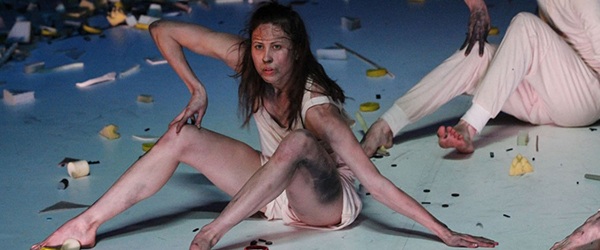Home | Blog | Score Part 2
Score Part 2
Image by Jeff Busby
A few weeks ago I wrote about Narelle Benjamin’s Hiding in Plain Sight and Hofesh Schecter’s Sun, two works within a weekend that promised a feast of dance, predominately held at Carriageworks as part of Performance Space season Score.
Observing so much dance in such a short period, representative of such diverse sensibilities and physicalities, gave me the same creative satisfaction I achieve from the choreographic process, each work challenging my perception of dance for different reasons.
When I heard anecdotal information about Gail Priest and Jane McKernan’s work One Thing Follows Another, I wasn’t sure I was going to enjoy it. This may be a mistake to confess as a commentator of sorts. I had a pre-conceived opinion that what I was about to see was a utilitarian representation, devoid of artistry.
Who exactly is this Yvonne Rainer who is responsible for me about to experience a sterile representation of the thing I love, reducing movement to simple action without motive or intent, where ‘no to heroes’, ‘no to eccentricity’ and ‘no to seduction of spectator by the wiles of the performer’ existed, as recited by Jane from Rainer’s famous No Manifesto? I had only ever encountered her via a recent video as an older woman participating in a comparative spoof between modernist and post-modernist approaches to dance with a famed Martha Graham impressionist Richard Move.
Before I knew it, I was completely engaged. From the receiving of party favours, consisting of a paper bag with mintie and a hand-made mini booklet promoting Fluxus activity; the underpinning art movement of John Cage and Yoko Ono (amongst many but both specifically cited in this work), which would later be used when requiring audience participation, to the opening where the four performers directly communicated the upcoming construct whereby action occurred in increments of 4,5,6,7, and 10 minutes (you get the picture).
Together we watched as Angela Goh interpreted lines and shapes drawn on a strip of paper as she slowly and systematically scrolled them towards her, bringing them into view via a mobile phone, capturing and transmitting via four large monitors, suspended above the stage area in the round, while Jane and Lizzie Thompson danced their representative version with a piece of doweling and Gail Priest did the same, though as a sound engineer shaping, distorting and mixing her voice.
A cake was baked, hands were shaken and names were taken, water was poured into bottles placed in a circle ‘until it evaporates’. These were carefully curated re-enacted happenings melded with inventions of the present. The audience as a community responded dutifully, reminding me that simple actions can be deemed significant, as it is a natural human habit to imbue meaning.
I have ruminated over Antony Hamilton’s work Keep Everything, which was inspired by how much creative input is actually discarded when a final product hits the theatre; be it the work that doesn’t quite fit in with the overall aesthetic and/or doesn’t clearly correlate to the overarching thematic intent, and how to utilise that material to effectively speak to the fragility of the human condition.
I enjoyed the onomatopoeic connection between movement and morphing state, the deep throated rumble from Benjamin Hancock from beneath the rubble, the thinking man commentary from Alisdair Macindoe who’s popping and sharp articulation of Antony’s choreography was mesmerising and Lauren Langlois’ malleable face enhancing the overall absurdist situational comedy.
I saw sinister duplicity, in seemingly benign action, in the animated panting dog and the extended birthing sex act, which I found simultaneously funny and repugnant.
The feminist within riled on autopilot, while the choreographer deemed myself a hypocrite. Don’t I employ this same fundamental approach? To simply state what is/exists, rather than let my individual moral attitude dictate how I edit, or if I edit certain material.
The success of this work was in its ability to entertain, and in its lingering ability to maintain thought and appreciation long after the season has finished.
Natalie Abbott’s Maximum was a fitting way to cap off the Score season pitting two bodies, the dancer (Abbott) and the wrestler (Donny Henderson-Smith) beside, against and in partnership with one another. This work revealed itself as a slow burn. We walked into the theatre to the rough and tumble of combative rehearsal, each performer aiming to tap the others legs whilst avoiding being tapped themselves.
Training moved up a notch with unison walks graduating to well-orchestrated runs and side to side gallops, both bodies matched, in synchronised step, to Daniel Amott’s live sound mix performed on stage in matching costume, with accompanying lighting design shifting in equal incremental measure. The movement progressed to pulsing ballon, in a wide stance; the sound of the downward pressure creating a groaning stress from the stage floor was amplified to become a part of the score.
It was around the time of the hoarse war cry, whilst on all fours, pumping torsos and silver shorts with bouncing buttocks inching closer, that my perception in the direction the work was headed, started to wane, only to be surprised and empathetically appreciative of Natalie’s body in bronzed trophy posture; the exultant slam dunk, arms aloft ready to follow through, eyes on the imaginary hoop, hips thrust as if in full flight, her swarthy partner as base, slowly pivoting in an endless circle. Again and again she falters and slips, faces her partner who becomes both adversary and trainer. I am exhausted, feel angst for her repeated efforts and a sense of accomplishment as she endures until the lights go down and we hear the full time whistle blow, marking the end of the work and the end of Score the season.
Can we petition for this to be an annual event yet?
– by Vicki Van Hout

